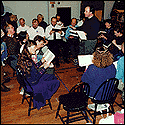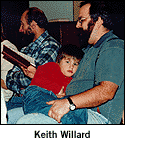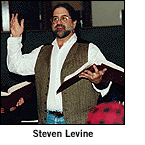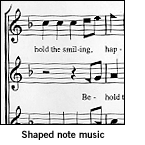December 1, 1996
Audio Features
Feature Story (7:00): RealAudio 2.0 14.4 or 28.8 file
Song 1: "David's Lamentation": RealAudio 2.0 14.4 or 28.8 file
Song 2: "Liberty": RealAudio 2.0 14.4 or 28.8 file
Song 3: "Raymond": RealAudio 2.0 14.4 or 28.8 file

Introduction
 Each week across the United States, thousands of people meet in churches and schoolrooms to perform one of the oldest styles of American music. It's called "shaped note" singing. The name come from the simple musical notation used in the songbooks. For years, shaped-note music was a southern phenomenon. But most of the southern singers are elderly now. Some fear their tradition might die out with them. Stephen Smith of Minnesota Public Radio reports that the future of this singular American music may depend on young Yankees up in the snow belt. (Want to know more? The Fasola Homepage opens the door to shape-note singing on the Web.)
Each week across the United States, thousands of people meet in churches and schoolrooms to perform one of the oldest styles of American music. It's called "shaped note" singing. The name come from the simple musical notation used in the songbooks. For years, shaped-note music was a southern phenomenon. But most of the southern singers are elderly now. Some fear their tradition might die out with them. Stephen Smith of Minnesota Public Radio reports that the future of this singular American music may depend on young Yankees up in the snow belt. (Want to know more? The Fasola Homepage opens the door to shape-note singing on the Web.)
Feature
Sound: Chairs on wooden floor
Smith: The way they arrange their chairs says everything. Shaped-note singers face each other in a square basses on one side, then trebles, then tenors, then altos. These musicians are perfectly content to keep their backs to the audience, if anyone came to listen.
Sound: Group gets pitch, sings.
Smith: The music is arranged by notes on a scale that goes fa-sol-la-me. And so the group first sings out the notes and then later does the tune with the actual words.
Sound: singing swells in volume
 Willard: This is not pretty music, it isn't intended to be.
Willard: This is not pretty music, it isn't intended to be.
Smith: Keith Willard sits at the back of the bass section in a flannel shirt and suspenders.
Willard: To stand there and listen is an unnatural act in this tradition. The focus is wholly on the singer. There's no accident that the metaphor for this is the hollow square...four sides all facing one another.
Sound: Music swells full
Smith: Keith Willard calls himself a "medical informatics professional"...meaning he's a physician who works with computer data bases. Willard holds the song book in one hand, the other chops at the air with a rhythmic snap. As you may have noticed and Keith will happily confirm anyone with any voice is welcome to sing.
Willard: Obviously people who have powerful, wonderful voices are appreciated for that contribution. But the person with the small, quavery voice in the back that may hardly sing is also valued.
Sound: Music swells to end of song, people clap
 Smith: Steven Levine hops into the center of the square to take his turn leading. A broad, blissful smile covers his face as he twirls to direct each section of the group. Levine's long, braided black hair dances along as he moves. His nasal voice punctures the air like a high-speed drill...and that's just fine.
Smith: Steven Levine hops into the center of the square to take his turn leading. A broad, blissful smile covers his face as he twirls to direct each section of the group. Levine's long, braided black hair dances along as he moves. His nasal voice punctures the air like a high-speed drill...and that's just fine.
Levine: There's this vast range of voices in the world, idiosyncratic voices. Everybody has this wonderful character in their voice that when they're trained to sing they get rid of . And then, by nature, I was given a funny voice...(laughs)...an odd voice that stands out anyway. One very, very old woman came up to me at a small church in Jasper Alabama and said, "Oh! You have such a beautiful voice, I can hear you from all the way across the church." (laughs)
Smith: Steven Levine is a Jew...but he sings these Christian odes and anthems because of shaped-note's old-time values of simplicity, neighborly concern and egalitarianism.
Levine: It was music where you got together with you family and your friends, with people you had known your whole lives, people they had known their whole lives, to be with each other for a day of singing. It wasn't a question of this pretty voice, this correct note, this conductor achieving his artistic vision through the expression of music. It's a communal thing, an egalitarian thing.
Smith: This communal form of music dates back to colonial New England.
 Cobb: They were bringing over what was then a social institution in the English parish countryside and Scotland as well, and that was the singing school.
Cobb: They were bringing over what was then a social institution in the English parish countryside and Scotland as well, and that was the singing school.
Smith: Buell Cobb of Birmingham, Alabama is a shaped-note singer and historian.
Cobb: The singing school was invented and developed to improve the quality of congregational singing, but in America it rapidly became an integral part of the social life of the community.
Smith: Back then, only the elites knew how to read sheet music. So, the common folk needed a simpler system.
Cobb: For centuries had been learning to sing by vocal syllables. the octave goes "fa-so-la-me fa so la me fa.' That system is a couple of hundred years older than the later do-re-me system. and, in 1801, a couple of tune book compilers came up with the idea of giving a distinctive shape to each of the notes so that you can look at it and instantly tell what pitch it was.
Smith: There are four shapes: triangle, oval, square and diamond. By the 20th century, shaped-note singing had migrated south. Small, rural churches kept the tunes alive. But Cobb laments that young southerners today have no interest in such a rustic relic.
Cobb: Anything that smells of an old country way of life represents everything that they're trying to move away from. Whereas, by contrast, people outside the south who often live in metro areas in a very frantic, rapid pace of life, they can come to this and say, "Wow! This is wonderful! I love the fact that this has roots, that it goes back, that it's old, that it sounds old.
Sound: Song starts
Smith: As numbers dwindle in the South, shaped note groups have formed in recent years in most of the major cities of the North and West. In St. Paul, Keith Willard and his wife Jenny often spend their family vacations traveling to shaped note singings around the country. Keith explains that the picnics and conversations enjoyed during a day of singing are almost as treasured as the singing itself.
Willard: It is very easy today in urban society to be alone, to be lonely, to be not part of a community even though you're living smack cheek-by-jowl. This is something that is a way for people to come together and share with one another at a very basic level with a lot of the conventional barriers removed.
Smith: Before the evening ends, the chairs fill with more than 40 singers. Jenny Willard's bold, classically-trained voice pounds out the treble notes. She loves the un-manicured, unrehearsed nobility of the music.
J. Willard: As you saw tonight, we'll sing thorough and we smash a song that's too bad. we don't go and try it again. we don't practice it. we do it once we do it all the way through, didn't work out that time well maybe next time it'll work out better.
Smith: One singer describes the joy of this ancient-sounding music as follows: In shaped note there is no audition...we sing in the key of convenience...there's no room for soloists...and the louder the better. For Minnesota Public Radio, this is Stephen Smith.
Sound: song ends, another starts...fades out.
Note: The singers in this story use the Sacred Harp songbook. While many refer to shaped-note singing simply as "Sacred Harp," the more general term was used in this radio story for narrative economy.
